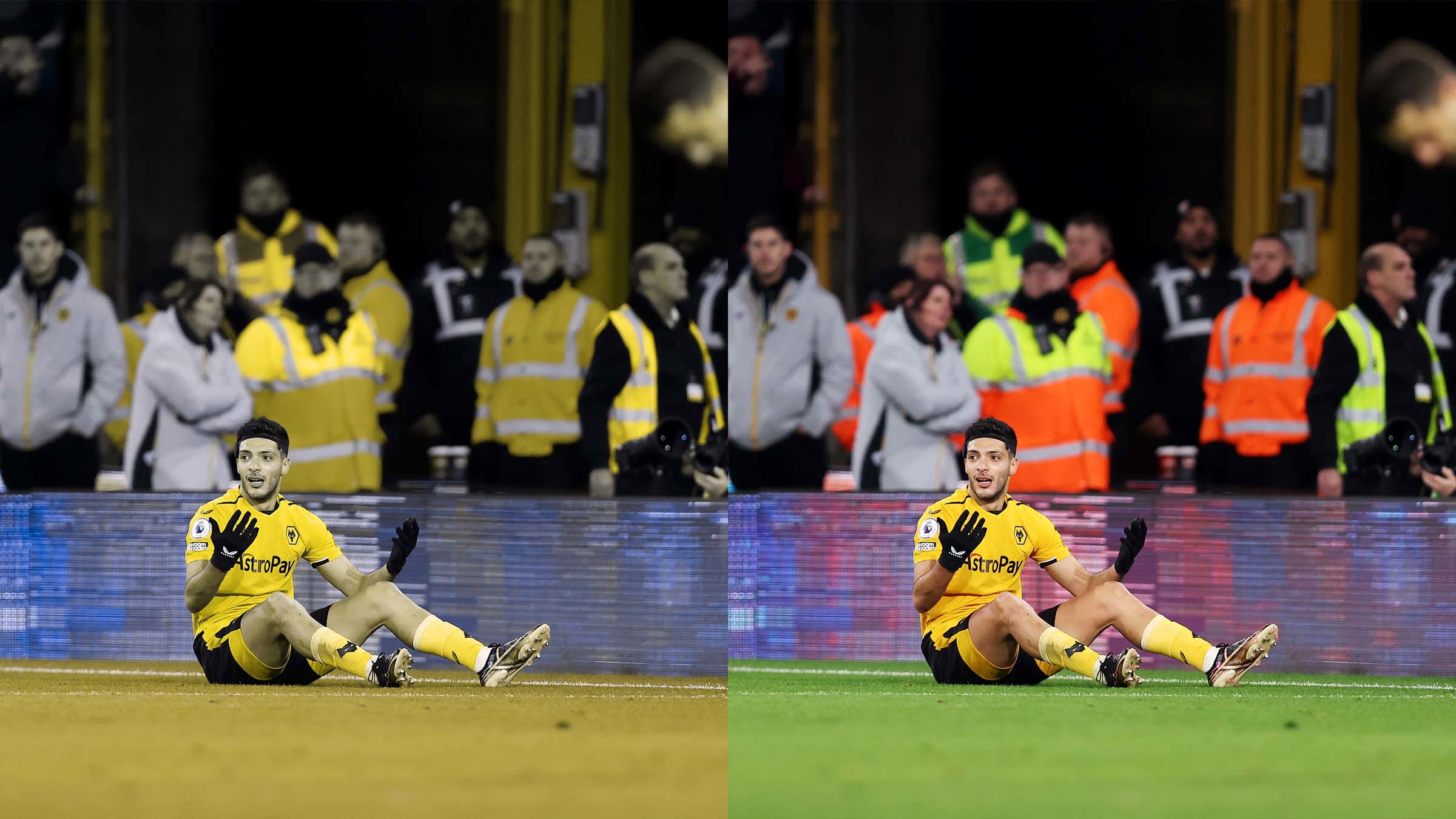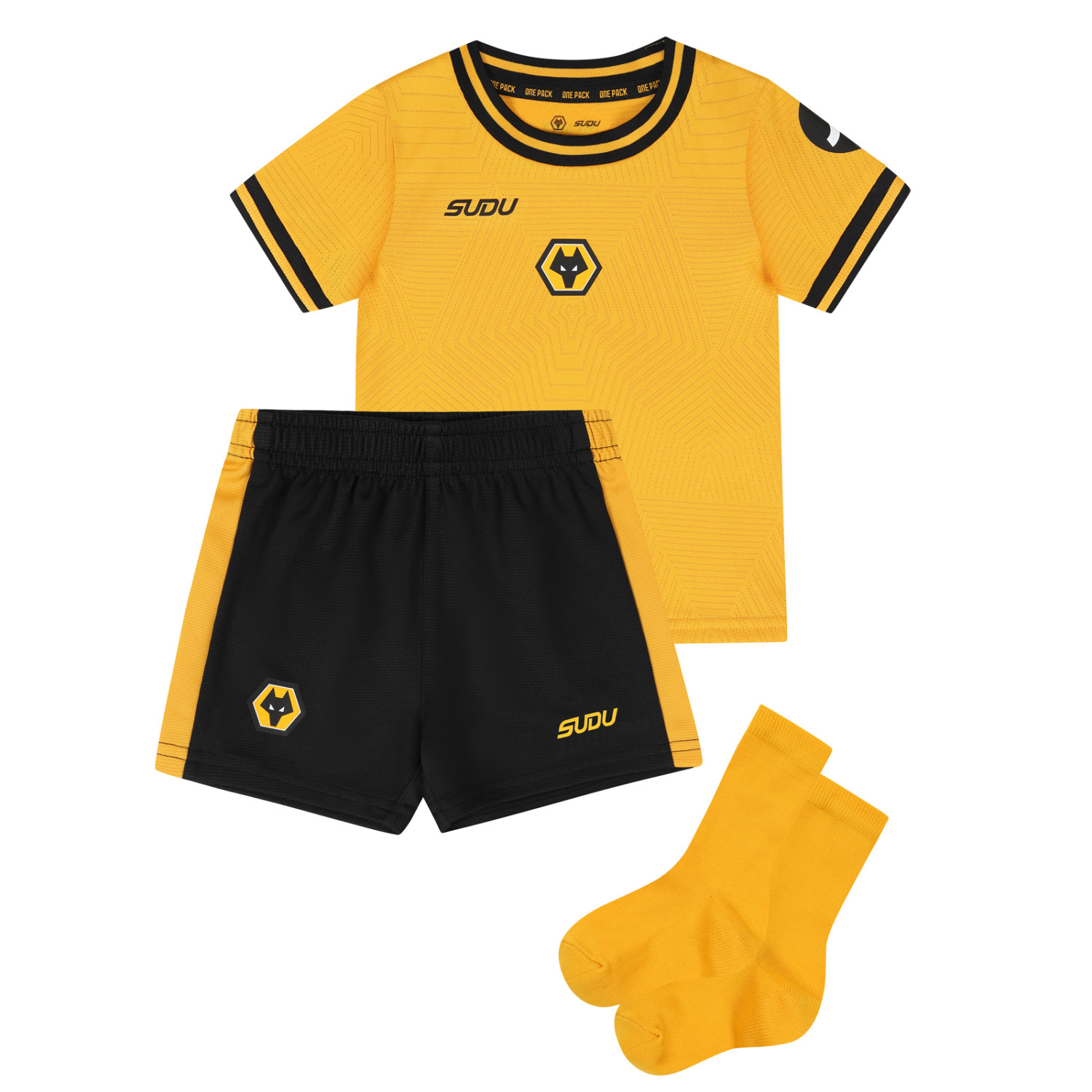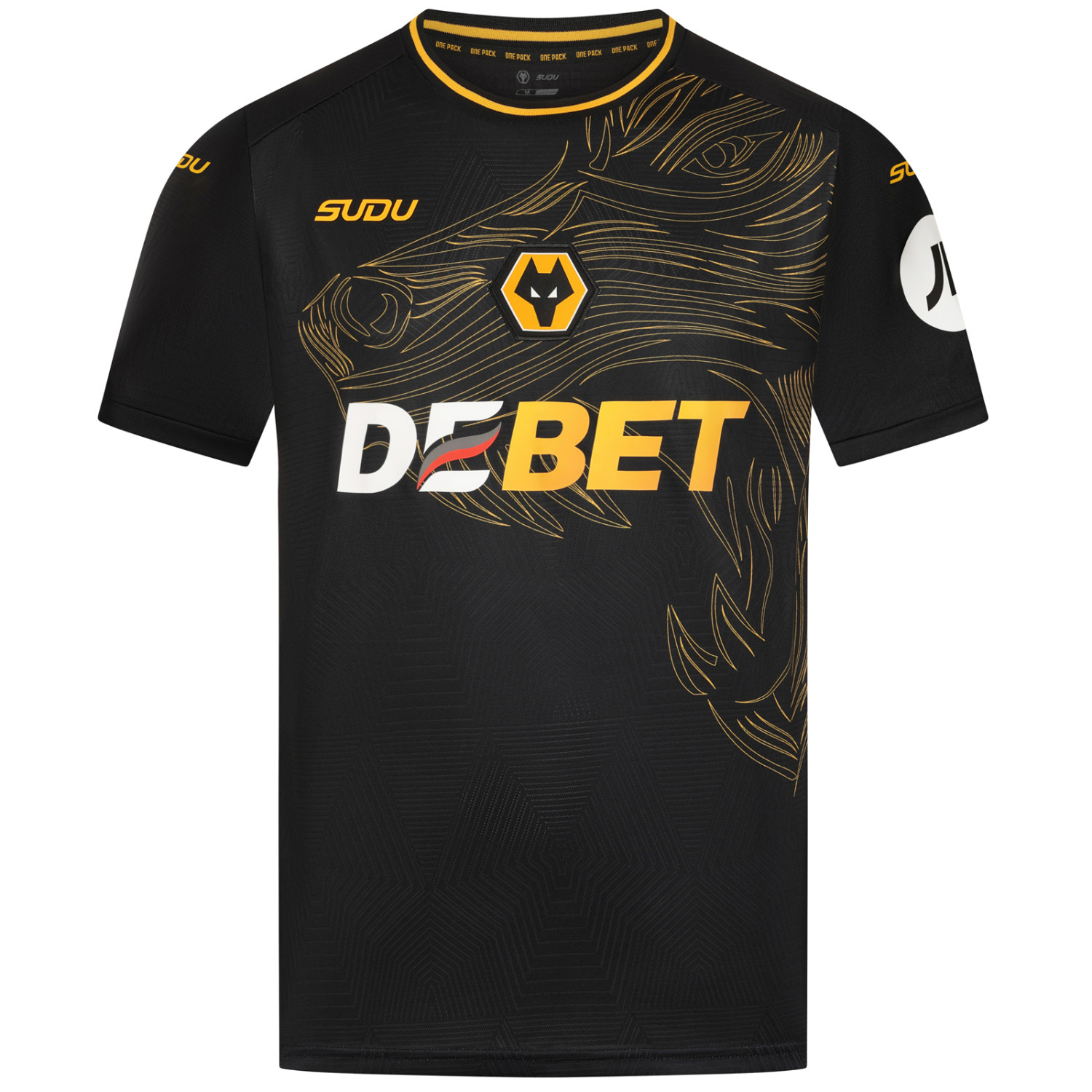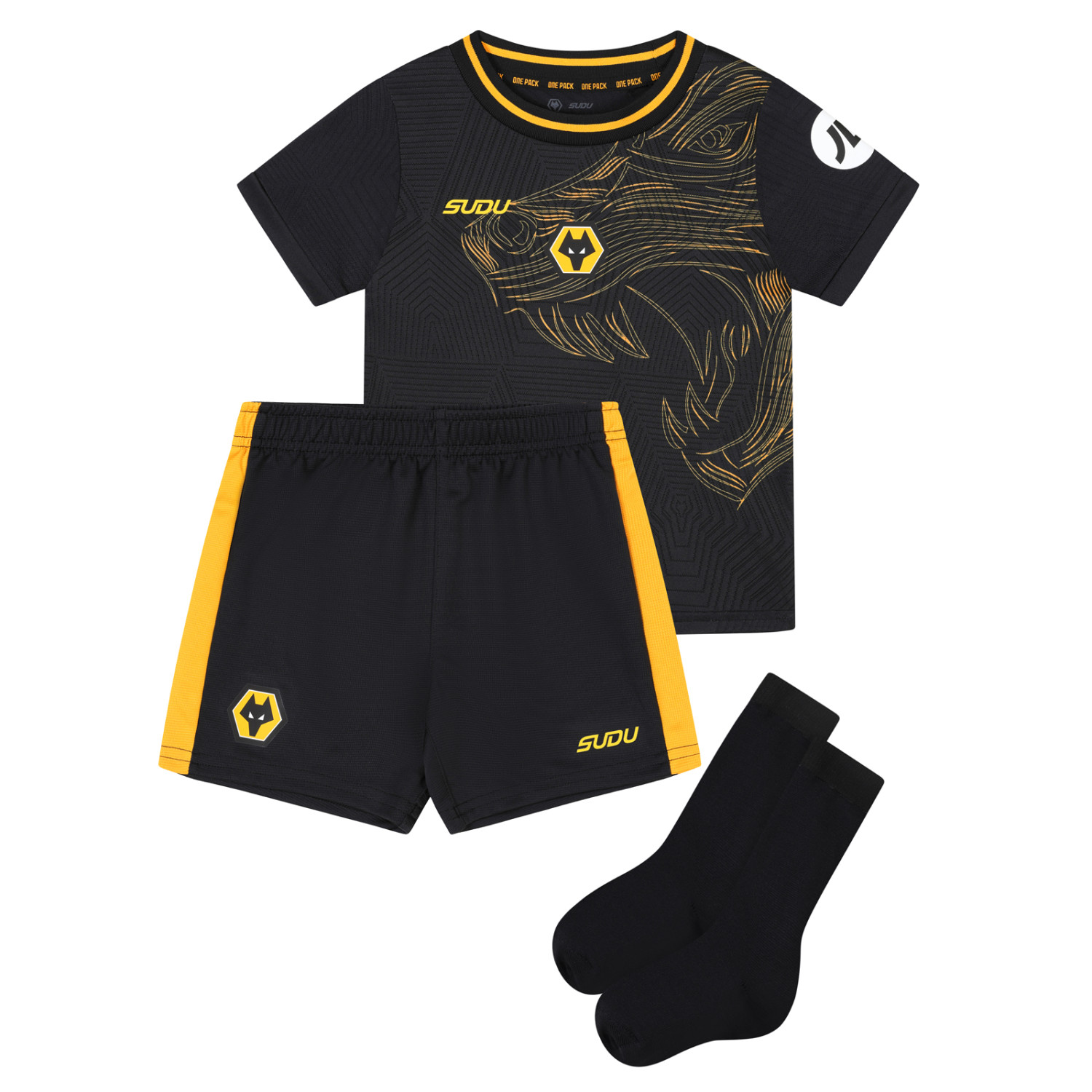Colour vision deficiency is a topic seldom discussed in professional football. Approximately three million people are affected by a colour deficiency in the UK, but given the nature of the condition, it’s been a largely untouched discussion until the last 12 months.
Contrary to the common misconception that colour blindness always appears to those affected as multiple shades of grey, the more regular conditions cause certain colours to clash and appear similar, with reds and greens the most common combination, followed by blues and purples.
Humans see colours through three types of cone cells in the eye which absorb red, green and blue lights. For people with a colour vision deficiency (CVD), one of the world’s most common genetic conditions, one cone type doesn’t function normally or at all. Most colour blindness involves defects in red or green cones, meaning the two colours appear the same.
One in 12 men inherit colour blindness, compared to one in 200 women, because, genetically speaking, it’s carried on the C chromosome. Around 300 million people worldwide have some form of colour blindness, and three million in the UK – enough to fill Molineux more than 93 times.
Of course, regular medical tests, and the fact no current players have confirmed the condition, means the proportion of Premier League footballers affected is likely to be low, but wolves.co.uk reached out to the Wolves workforce, offering an opportunity to share their story.
Four members of the backroom teams at Molineux and Compton Park stepped forward – Will Clowes, head of the Wolves Foundation, Steve Hooper, under-18s academy kit & equipment lead, Lara Pegg, Foundation HR manager and Dennis Green, Wolves Disability Supporters Association (DSA) committee member – and for the first time in a journalistic capacity, sat down to give a fascinating insight into the conditions which all insist don’t hinder their lives, but require an adaption.
Conversations began within the professional game last summer when former Republic of Ireland and Charlton Athletic midfielder Matt Holland revealed he couldn’t easily differentiate between greens and reds – ironically the colours of his club and country – with his Addicks debut against Plymouth Argyle causing a problem with kits, likewise bibs and cones in training.
Hooper, who manages the kit department for Wolves’ under-18s, can relate to Holland, given reds, greens and browns regularly clash for him, but his responsibilities on a matchday and in training within the Wolves Academy gives him the luxury of controlling a factor which is rarely considered by those without a colour deficiency condition.
Speaking at Compton Park training ground, Hooper was preparing the under-18s’ arctic ice third kit before their recent trip to Liverpool, and although Wolves are in the fortunate position that their kits rarely clash so he had his pick of the club’s three kits for the trip to Merseyside, training equipment can be less straightforward.
“We’ve got blue and purple bibs, which I struggle with,” Hooper revealed. “If the coach asks me for three sets of bibs, which he generally does for training, I won’t give them blue and purple and it’s probably because I feel more comfortable giving them different colours.
“I’ve got a bag of cones I give to the coaches, and I purposely steer clear of colours I perceive to be fairly close, even if other people think it’s ridiculous. It’s more a nuisance, it’s not something which hugely affects me day to day, and there’s anyways somebody I can lean on. Once you’ve adapted to the colours you’re playing in during the season, and the cones and bibs we’ve got, you get into a routine.
“I always carry three different goalkeeper kits to games, in case there are clashes. If there’s any doubt, I tend to go to the referee, and they’ll advise me if I need to change. We declare our colours before we go, but on the day there could still be a slight clash, so we’re prepared.
“It’s quite a unique condition because people who don’t understand it, don’t see it. My wife is forever asking me why I’m picking certain colours, when I’m confusing purple with blue. Our goalkeepers over the last few years have had shades which have been a bit of a nightmare for me. Our third kit, arctic ice, isn’t too different to our home goalkeeper kit, which is a pale blue, so I have to really concentrate.”

Deuteranopia: Colour blindness resulting from insensitivity to green light, causing confusion of greens, reds and yellows.
At both Compton where Hooper is based, and Molineux where Pegg finds her desk, Wolves’ unique pantone runs throughout the club’s branding. Pegg, one in 200 females affected, differs from the other three participants in that yellows and blues prove the most problematic for her.
That rarer combination issue delayed diagnosis – regular eyesight tests as a child examined Pegg’s red, green and brown clashes, which she comfortably passed. It took until her early 20s before more extensive tests confirmed the yellow-blue clash, which leaves her still uncertain on exact tones in her role at Wolves Foundation.
Pegg said: “At work, I don’t actually know what colour the Wolves brand is. I look at it and think it’s bright yellow, or orange or brown, but I can adapt the colour scheme by using an ink dropper, and it makes the colour. Everywhere I’ve worked I’ve done that, so if I need to do anything branded, I’m aware that’s the correct colours.
“At my old job, the logo was purple, blue, red and pink, and I couldn’t tell the difference – pink and red looked the same and purple and blue looked the same. They made a newsletter and once I couldn’t read anything on it because of the colours – it must have looked lovely, but I had to request a blank one with no colours.
“As daft as it is, some of the signs around Molineux are gold with a light font, and I have to concentrate because the colours almost blur. If I sit and look at it, I can tell, but if I look at it fast, I wouldn’t be able to read it.”
Sat in the same office was Foundation colleague Clowes, who has been aware of his condition for more than 40 years, since confusing his painting colours as a child. His intrigued mother took him for tests, which confirmed the more common red-greens-brown clashes, and Clowes was subsequently handed a photocopied sheet of jobs he could not pursue as an adult – he couldn’t be a fighter pilot, whether he liked it or not.
Fortunately, the deficiency has little bearing on his role as head of the Wolves Foundation. Keen to reiterate that being colourblind doesn’t require sympathy from others – it’s not a hard luck story – it’s more of an intrigue, which is being satisfied more in recent years.
Having recently attended relevant conferences of nearly 40 people in both Rotterdam and Budapest, Clowes signed up to the European Football Development Network, the organisation tackling colour-blindness in sport, and was happy sharing how the deficiency affects his job both at the events and to wolves.co.uk.
Clowes said: “When I’m on Excel, and I’m changing a tab colour, I go on the primary colour pallet and I’ll hover, so it tells me the colour. The tabs are so small, if I see a full red and green column, I can see the difference, but not when they’re tiny blocks. I don’t have the confidence to say it’s definitely brown, but it’s not an issue, you just adapt, and as technology moves forward, there’s definitely more consideration for it.
“We’re quite fortunate because we’re a contrasting colour at Wolves – we’re not a red or a green. It’s not often we have to change kit on the pitch. When both teams are in stripes, I can find that difficult when both teams in dark shorts, if they’re still it’s OK, but it’s the movement which confuses me.”
In February Ireland and Wales met in the Six Nations and wore their traditional green and red kits, which caused controversy. Previously, World Rugby released guidance recommending against such clashes, but their kits are produced on a two-year cycle and neither had a suitable replacement, which led to viewers “switching off” their TVs, according to the governing body.
Wolves have no such problems – the club’s old gold, teal and arctic ice strips can be differentiated by those living with CVD. Wolves supporter Green learned of the condition at the age of 11 through a colour perception test, but hasn’t let it affect his life, including the support of his hometown club.
Green said: “Wolves are getting more savvy with Fan Services. I’m not the sort of person who would moan or say something wasn’t fair because I’m colour blind, because it’s not that serious. There could be other colour perception levels where it makes a major difference, but I’m confident at supporter level that there would be help, so there’s no criticism of the club.
“I regularly shop in the Wolves Megastore and when I’m looking for stuff, I don’t have any problems because they’re quite distinctive shades. I don’t buy the peculiar stuff anyway – some of the colour’s clubs use for second and third kits could cause a problem, but Wolves have been quite good over the years so it hasn’t really affected me.”
Last June, the EFL introduced a new rule which allows clubs to wear their away kit at home matches, should a clash which could cause people difficulties to differentiate colours occur, while the Premier League also provide guidance to clubs to avoid similar issues.
What kitman Hooper could provide to the study was experience of playing the game. The now 68-year-old played non-league football for the likes of Halesowen Town and Hednesford Town, but admits the traditional kit colours at that level, coupled with the era he played in, made life much easier than it would be today.
Hooper said: “From a playing perspective, it didn’t really affect me too much. I’ve never gone out on the pitch and not known what side I’m playing on. Back in the day, there wasn’t the variety of kits that are today, it was often red and blue. If I’d said something, I think at that time they’d have probably laughed at me and told me to get on with it. I don’t think it would have gone down well with the managers I worked with.
“Goalkeepers wear predominantly green and it’s when green goes towards yellow. If you look at the spectrum, green goes into light green, then fluorescent green. Fluorescent green and yellow are basically the same colour. If you gave me a normal green shirt and a yellow shirt there wouldn’t be a problem, it’s when they merge. Most people can tell they’re close, but I’ll acknowledge it earlier.”

Tritanopia: A rare form of colour blindness resulting from insensitivity to blue light, causing confusion of greens and blues.
These conversations in sport are occurring more regularly. To eradicate similar problems to the Six Nations, NFL clubs have created all-white kits to utilise when there might be clashes.
For Pegg, she finds colour clashes on screens more problematic than in real life. She said: “I find I struggle more on TV. We talk about bibs, if you put a pile of green and yellow bibs, if I concentrate, I can see the difference, but running on a screen, I can’t see it. I find different lights difficult too – natural and unnatural lights make colours different. If there are Wolves shirts, orange bibs and yellow bibs, it all blends into one colour.
“I went to watch the Batman film and had to leave because it was so dark, I couldn’t tell what was going on. I could tell it was a car scene from the noises and speaking to my friend, but it was too dark and everything was moving too quick to work out. If I was at home, I would have just adjusted the TV.”
In 2010, Kathryn Albany-Ward’s seven-year-old son, who supported Manchester United, became frustrated by being unable to distinguish teams in a Champions League game, before it transpired that he was colour blind. He switched off his TV in frustration and has rarely watched football since.
This led to Albany-Ward setting up Colour Blindness Aware, a not-for-profit organisation trying to secure change in sport. With the help of Level Playing Field, a charity which campaigns to help disabled fans in sport, she presented to UEFA, FIFA, the FA and Premier League. Together with the FA in 2017, she helped create guidance documents on the topic.
The Wolves Foundation work closely with children the age of Albany-Ward’s son every day and Clowes’ own condition allows him to be empathetic and aware of the more progressive way the club’s official charity could be working.
Clowes said: “We can make sure there’s a consideration when we’re creating resources. We produce a huge amount of teaching resources within schools, but don’t really take it into consideration, but we should. That’s an education for us and for our designers. Our work goes from pre-school to 90-year-olds, we provide graphics, literature, artwork, so it’s a wider consideration we’d need to implement, without making it a big deal.
“I was sat in a briefing recently which works with the major governing bodies in sport, and you find yourself agreeing with the points being raised and reminding yourself that there has perhaps been a problem in the past. It’s never been an issue to talk about it, I’m never offended, you make some bad colour choices with clothing or paints, but it’s never really an issue.”
While colour blindness has never truly affected Clowes’ career in football, Wolves supporter Green, now aged 72, was less fortunate. Having been first selected to serve with the RAF in 1977, Green spent ten years in work before being put forward for an air force driving permit, which led to eye tests in 1987. He spent 22 years with the air force, but it was at that moment things changed.
Green said: “When I was put forward for the permit, I had to do a colour perception test, and I failed it because I was level four colour blind. When they diagnosed me, it was mainly reds, greens and browns, and it was to do with the shading. I was supposed to be a flight simulator technician, but I couldn’t do it because I was colour blind. It affected my chosen role in the RAF, but only because I had to do another trade.
“The RAF were quite thorough with the tests they did, so if I was doing a job which meant electrical wiring, they couldn’t risk me getting colours mixed up. The job I ended up doing was more structural, hydraulic and pneumatic based, engineering.
“Then I got a job at Cosford Aeronautical Engineering School, as a civilian in 1999 and I was there for 19 years. I wasn’t affected there because it was my trade, and I didn’t do anything electrical. I raised that I was colour blind at my interview, they didn’t ask, but I declared it and it didn’t affect my selection.”
It’s possible that supporters inside Molineux on Saturday afternoon when Wolves faced Brentford have some form of CVD and are not aware, having not taken appropriate tests yet. That was the case for Pegg, who eventually got to the bottom of her condition through a series of tests via an optician.

Steve Hooper, Lara Pegg, Will Clowes and Dennis Green.
Pegg said: “On my test I had to click when you saw a different shaded square and they kept telling me to engage in it – they thought I wasn’t taking it seriously, but I couldn’t tell the differences and ended up clicking randomly. They picked up a pattern and said I had a deficiency with shades.
“I’ll disagree on colours with my mum, so she’d tell me to try on a purple dress and I’d think it was blue. I have to take an extra five minutes to get ready in the morning and make sure everything matches.
“I can look at a colour, think it’s one thing, then look away and back again, and it’s different, but if I concentrate, I can do it. I’d never decorate a room by myself without somebody checking the colours, my mum had her kitchen done 12 months ago and I asked her why she had a lilac kitchen, but it was taupe, but I didn’t know. She always thought I had something, but there was no history of colour deficiencies in my family.”
The fact Pegg had no family history of colour blindness made detecting more difficult. For Clowes, there was no such issue. Passed down through generations of men in the family, colour blindness is fact of life for many of his relatives, which is likely to play a part in his unfazed approach to the condition.
Clowes said: “It runs through my mum’s bloodline, so her dad, my grandfather was colour blind, but my mum’s not. It’s all through male relatives, so my uncle, three cousins and sister’s son, who is 16.
“It’s a point of ridicule with my kids, which they find highly amusing, but it doesn’t affect me really. When you stop and think about it there might be odd occasions where you’re a bit confused by something, maybe buying tickets online and you can’t determine which seats are available. It’s nothing significant or life changing.”
Clowes highlighted it could be simple additions which assist his life. Signposts rather than coloured car parks. Vacant and in use signs, rather than red and green. Written nutritional details on foods.
While sat in the Foundation offices in the Sir Jack Hayward Stand, mid-interview, Clowes and Pegg conduct eyesight tests online. Those tests are conducted by Green too, likewise Andy Pike, the vice chair of the DSA, who also has a similar condition. Green, who speaks with a confidence of his condition, refuses to let it be more than a tool for humour now.
Green said: “It’s a family joke – ‘What colour is this dad or grandad’ and I play along and say it’s pink when it’s red. It’s quite light-hearted around the family. The funniest thing I witnessed was when I played snooker in a local league. There was pink, red and brown, and they used to wind me up, but it didn’t affect me because the shades were OK.
“I don’t expect the world to change just for me. There are far more serious conditions or situations where it may affect people more, where it could be dangerous, but for myself, I get on with it. With family and friends, it’s treated like a joke, nothing for me to complain about and I’m happy with what the club would do if I did raise a concern.
“As part of the DSA, we do tell our members that no question is too much. Give us feedback and we will pass it through to the club and it’s worked out very well over the years. I’ve been involved in the DSA since the start, and nobody has ever said anything to me, about colour blindness”
That attitude is reflected with the Wolves Academy with Hooper, and goalkeeper coach Jon Flatt, who has a similar condition, which provides mutual chat, and entertainment for their colleagues on away trips.
Of course, it’s a topic which should always be taken seriously. Colour vision deficiency affects people differently and may hinder life for some more than others. Hooper, who worked as a development engineer at aerospace before arriving at Wolves, admitting this interview with wolves.co.uk was the first time he’d spoken officially about his condition.
He’s willing for that to change, however. Hooper is around young footballers aiming for the Premier League every day and hopes awareness of his condition could prove an inroad for any youngsters who are affected and need some advice.
Hooper said: “Ultimately, any eyesight deficiency is going to hinder a player’s career, but hopefully colourblind maybe not as much. What I’d say is I worked in an industry before Wolves and throughout my life, considering I’ve had a deficiency with colours, it’s never held me back from doing anything I want to do.”
If anyone affected by this story requires more information or support from Wolves, a helping hand is available via fanservices@wolves.co.uk and 01902 810485.



























